|
|
Note from Editor - More Tribute to Tinplate!
This is a unique project that Howard thought up when he came across an old glasses case and realized it would make a good roof for some sort 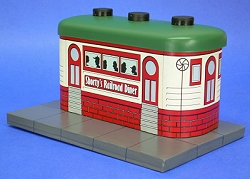 of tinplate structure. But what kind? Well, considering it was almost the size and shape of the roof of the Marx passenger cars Howard recently acquired, the project almost suggested itself. of tinplate structure. But what kind? Well, considering it was almost the size and shape of the roof of the Marx passenger cars Howard recently acquired, the project almost suggested itself.
Until I started researching this project, I thought that all of those old railroad-car-style diners I've seen over the years were built out of actual railroad cars. It turns out that relatively few ever saw life on the rails. But the railroad dining cars, with their bench seating and single long aisle turned out to be a good "prototype" for any restaurant owner whose business plan depended on getting people in, served, and out quickly. So diners that looked like railroad cars appeared all over the country within a few years of the first business successes.
Although several model roadside diners have been made to go with O gauge trains, most of them have been plastic. This project is made to go with earlier trains, such as the early 20th century trains that were mostly made out of tinplated steel, and given "detail" by a lithography process that is all but lost to us today. Because of the size of the eye-glasses case Howard started with, it is pretty short compared to the "real thing." But it's an ideal addition to a railroad on which the average passenger car is only 24 scale feet long. :-)
If you don't have an old symmetrical eye-glasses case you can sacrifice to this cause, there's no reason you can't cut out a piece of wood the right size and shape, then take a belt sander to it to round off the corners. I've also made the graphics with plenty of extra material on the side of each piece, in case you need to expand or shrink the overall project. Enjoy!
Paul
Building a Vintage-Style Diner
 When I showed Paul one of my "mockups" for this project, he offered to push some other projects aside and make the graphic for this project. He and I exchanged dimensions and test files several times until we found a combination that looked right with the glasses case I started with. If you have a glasses case you can use, chances are the measurements will be a bit different, but there is a lot of "give" in the patterns, so you'll proably just need to experiment. When I showed Paul one of my "mockups" for this project, he offered to push some other projects aside and make the graphic for this project. He and I exchanged dimensions and test files several times until we found a combination that looked right with the glasses case I started with. If you have a glasses case you can use, chances are the measurements will be a bit different, but there is a lot of "give" in the patterns, so you'll proably just need to experiment.
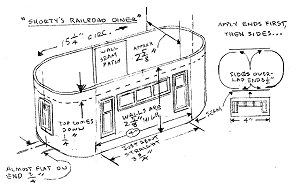 The drawing to the right shows one of the drawings I sent to Paul to help him figure out exactly how big each portion of the graphic should be. We're including it in this article because it shows helpful details of the construction. If you click on the the drawing, you'll get a bigger version. The drawing to the right shows one of the drawings I sent to Paul to help him figure out exactly how big each portion of the graphic should be. We're including it in this article because it shows helpful details of the construction. If you click on the the drawing, you'll get a bigger version.
What You Will Need
- For a metal roof, find an old eye-glasses case that is symmetrical and that nobody will mind you disassembling. If you can't come across such an item, you can always make the roof from a block of wood, and sand down the corners with a belt sander to give that smooth look. In fact, if you're building this project in a much larger or much smaller scale, you'll pretty well have to use a wood roof.
- For the roof vents, I used plastic screw caps from hardware store held on with sheet metal screws.
- For the diner body, I used clean solid cardboard, such as from cereal boxes or the backs of writing tablet.
- Corrugated cardboard for the base and foundation
- A sharp mat knife or Xacto knife
- Elmer's white Glue-All. A glue stick would also come in handy.
- Several sheets of acid-free white bond paper
- Access to the Internet and a color printer.
- Paint for the roof
- Clear indoor-outdoor acrylic spray to add a metallic appearance to the final product.
For a more comprehensive list of tools and supplies that come in handy on any cardboard house project, please refer to our article What You Need to Build Glitterhouses.
A Note about Scale
Because my Marx tinplate trains are smaller than they would be if they were actually built to scale, Paul has calculated the door heights, etc. for this project as closer to S scale. This size looks good, not only with old toy trains, but also with Christmas villages, so it will be the favorite size with folks who try this project. The plans are also in S scale. But in case you want to build a true O scale structure or you want to build a diner large enough to go with Large Scale or Standard Gauge trains, Paul has also provided graphics for those sizes as well. You WILL have to adjust the sizes shown on the plans if you choose one of the larger scales. But then again, it's likely you'll have to do some adjusting anyway.
Prepare the "Roof"
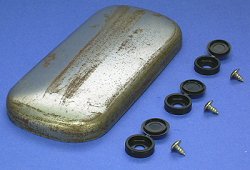 The ultimate size of your project depends on the size of the eye-glasses case you are using as a roof. If you're making the roof from wood, of course, you have total control over the size. The ultimate size of your project depends on the size of the eye-glasses case you are using as a roof. If you're making the roof from wood, of course, you have total control over the size.
The eye-glasses case I used came coated with vinyl. I used a needlenosed pliers to pull the hinge pin out of the hinge. Then I nipped the hinge off as cleanly as I could and peeled away the vinyl covering and the liner. This allowed me to use the "roof" to get the rest of my measurements.
In the photo above right, you can see the plastic screw caps I used to represent roof vents. You'll probably think of something you like just as much, but there they are.
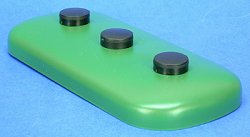 Eventually, I cleaned off the roof, primed it with a light coat of rust primer, finished it with green spray paint, and installed the vents. However, as you'll see further down, I didn't do that until I had the rest of the diner ready to go - that way I didn't have to worry about scratching the paint job while I was using the roof to doublecheck the size of things, etc. Eventually, I cleaned off the roof, primed it with a light coat of rust primer, finished it with green spray paint, and installed the vents. However, as you'll see further down, I didn't do that until I had the rest of the diner ready to go - that way I didn't have to worry about scratching the paint job while I was using the roof to doublecheck the size of things, etc.
Print the Patterns
This project has outline patterns based on the dimensions of my original project, plus graphic files you can use to complete the appearance of the diner.
You may print the structure pattern on any sort of paper, since you're simply using this to transfer the plan to your cardboard medium. However the "lithograph" graphic should be printed on acid-free heavy paper or card stock.
Printing the Plans - You may use cheap copy paper for the plans since you're only using them to transfer the patterns to your cardboard. If you have Adobe Acrobat Reader on your computer, click on each drawing above to get a full-sized pdf version that you can print. When you print, you may have to select "auto rotate and center" or something similar to get some of the drawings to print out right, but make certain that they print at 100% size.
Keep in mind that the ultimate "footprint" of your diner depends on the size of eye-glasses case you started with, so these plans are "suggestions."
 Printing the Graphics - We've provided three versions to help you print the "lithograph" graphics at the size you need. Printing the Graphics - We've provided three versions to help you print the "lithograph" graphics at the size you need.
Each sheet should be printed on acid-free high-grade paper or card stock. Note: Consider printing this sheet in black and white first to double-check the size against your existing equipment and/or the eye-glasses case you are using.
- As Shown - For use with S Scale or O-gauge tinplate trains (such as Marx tinplate and smaller O27 trains), download the S Scale Ends and Sides graphic.
- O Scale (Larger) - For use with true O scale model trains, download the O Scale Ends and Sides graphic. Also, if you want an HO scale structure, download this file and print it at 50%.
- Large Scale/Standard Gauge (Much Larger) - For use with Large Scale (garden) trains or old-fashioned Standard Gauge trains, download the following two files:
Note about Other Sizes: If you want an HO building, try downloading the O scale graphics, then printing at 50%. If you need the lithographed-style graphics for any other scales, contact Paul.
Also, if you don't have Adobe Acrobat Reader on your computer or for some reason that doesn't work, contact
Paul and ask him for help - that's his department. :-)
A note about Copyright - However you use these plans and graphics for your personal use, please keep in mind that the lithograph graphic is copyright by Paul Race and is not to be copied, re-used, republished, or repurposed without prior permission and appropriate credit. Commercial use without prior permission is illegal and expressly forbidden. Paul likes making resources like this available to hobbyists, but they are expensive and time-consuming to produce and publish, and it's frustrating to see other folks profiteering off his hard work. In other words, if you like having this kind of resource available and you'd like to see more, please respect the creator's rights.
Building the Base
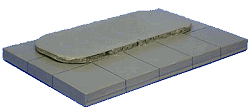 The base is a rectangular "box" built up from corrugated cardboard. The foundation will be covered once the building is fastened together, so it may be a single piece of thick corrogated cardboard or a piece of foam core board (shown). The base is a rectangular "box" built up from corrugated cardboard. The foundation will be covered once the building is fastened together, so it may be a single piece of thick corrogated cardboard or a piece of foam core board (shown).
- Make the base from three or four layers of corrugated cardboard glued together in a sandwich.
- Wrap and glue a strip of cereal-box cardboard all around it to camouflage the rough edges of the corrugated cardboard.
- When the base is built, cover it with white bond paper just like you would wrap a gift, except that all surfaces of the paper cover must be glued down to the box. A glue stick works great for this.
Note: For more information about building bases for vintage-style cardboard houses, please see our Glitterhouse Bases article.
After you have built the base, cut the foundation piece out, using the "top and bottom" plan for size and shape, and set it loosely on the base. Position your building over it to make certain it is a secure, but not overly tight fit.
Painting the Base
When you're finally certain that the diner will fit on the base properly, prime the base and paint it with several coats of glossy paint in the color of your choice. Industrial gray was the color most often chosen for this kind of structure in the tinplate days.
For this project, I also "graphed out" squares to represent sidewalk lines and drew them in with a fine black ball-point pen.
Fabricating the Inside Top and Bottom Bracing
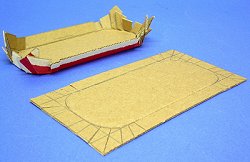 Although this structure takes its overall shape from the shape of the roof, it also needs internal reinforcement to keep its shape. The photo to the right shows the top and bottom that will actually sit "inside" the body of the diner. The little tabs fold up (or down) into the diner walls to help them keep their shape. Although this structure takes its overall shape from the shape of the roof, it also needs internal reinforcement to keep its shape. The photo to the right shows the top and bottom that will actually sit "inside" the body of the diner. The little tabs fold up (or down) into the diner walls to help them keep their shape.
When you cut and fold these, test to make certain that they will fit INSIDE the roof dimension, even after you've added the additional thickness of the walls. Also, remember that the bottom piece sits up a bit to make room for the foundation.
Building the Diner Walls
 Please refer to the sketch above for an idea of how the walls go together. Also, the diner cross section diagram shows the relative position of the bracing inside the walls. Please refer to the sketch above for an idea of how the walls go together. Also, the diner cross section diagram shows the relative position of the bracing inside the walls.
As mentioned before, I did several mockups before I decided on the final dimensions, so you'll want to test at each step of the way to avoid having to do a bunch of work twice.
Note about Height: While you're doing your mockups, think about the height of the structure. Paul gave me extra "steps" and an extra row of bricks on the bottom so I could wap the graphic around the bottom without any white showing. Then I forgot that was what the extra row was for and incorporated them into the structure. As a result, Paul thinks that my diner sits just a tad higher than it should. Set your mockup near other structures on your railroad to decide how tall you think it should be before you start gluing walls together for "good." Remember, this is YOUR structure, and the person you have to satisfy with this project is you.
I cut out the side walls and wrapped them around the internal top and bottom bracing. I checked THAT against the roof piece (not shown) before I glued it all together.
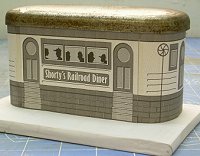 Apply the Graphics Apply the Graphics
Before you start gluing the graphics on, do one more "mockup," using scotch tape to put the graphics where you think they should go. This is your final chance to check the fit.
Once you are satisfied:
- Apply the printed graphics. Only do a section at a time. I like to start with the ends. As you can see, there aren't exactly any corners, so you have to get the doors on the end as well as you can, and work your way around. Then when you place the walls, use the "fluting" pattern on the end to get the walls as centered as possible.
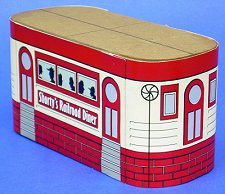 After the graphic sheets have dried in place, you will see white edges where the paper cut runs through the red strips. With a red felt-tip pen or marker or with acrylic paint and a very tiny brush, carefully coat just the edge of the paper or card stock to camouflage the edges. After the graphic sheets have dried in place, you will see white edges where the paper cut runs through the red strips. With a red felt-tip pen or marker or with acrylic paint and a very tiny brush, carefully coat just the edge of the paper or card stock to camouflage the edges.
Final Assembly
Once the glue is dry on all of the graphics, it is relatively simple to glue the structure solidly together.  That said, you may want to check on it every so often to make certain that something doesn't shift out of place while it is drying. That said, you may want to check on it every so often to make certain that something doesn't shift out of place while it is drying.
Finish
Wait until all of the glue is thoroughly dry (usually at least overnight), then spray the building with several light coats of a clear glossy indoor/outdoor acrylic finish. This protects it somewhat from moisture and dust. It also helps reduce fading and makes the lithography pattern "pop." Do not such a heavy coat in one pass that you cause any streaks, runs, or drips, though, or you'll have to start over.
This usually looks good near a depot, somewhere where people waiting for or coming off a train might nip in for a cup of hot coffee.
Conclusion
If you like this project, stay in touch - more are on the way. In the meantime, you might like to take a look at the following bonus graphic, as well as a long list of projects that would look good next to this one. 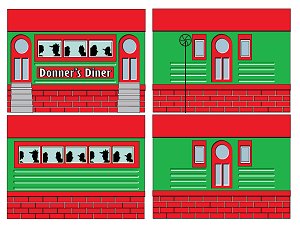
Bonus: Christmas Graphics - As an extra holiday gift to our readers, we're including a set of S Scale Christmas Diner graphics you may use to produce an especially "festive" version of this project for your Christmas village or Christmas-themed railroad. For now, we're just providing the size of the project shown above (for use with S Scale or O-gauge tinplate trains or Christmas villages). If you need another size, contact
Paul.
Related Articles - If you liked this project, take a look at the following:
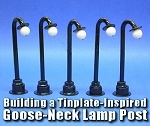 Building Tinplate-Inspired Goose-Neck Lamp Posts Add even more vintage variety to your tinplate-inspired communities, for less than $1 each worth of materials. Free downloadable instructions are provided. Building Tinplate-Inspired Goose-Neck Lamp Posts Add even more vintage variety to your tinplate-inspired communities, for less than $1 each worth of materials. Free downloadable instructions are provided.
- Building a Vintage "Lithographed" Station" - the first article in our "Tribute to
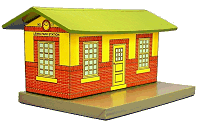 Tinplate" series, based on a prewar American Flyer standard-gauge station. Includes free, downloadable graphics, plans, and instructions for modeling in O/S and Large Scale/Standard Gauge. Tinplate" series, based on a prewar American Flyer standard-gauge station. Includes free, downloadable graphics, plans, and instructions for modeling in O/S and Large Scale/Standard Gauge.
- Building a Vintage Tin-Style Cottage - This project is inspired by a popular pre-war tinplate
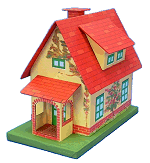 house that was made to go with standard gauge trains, like the early 1900s-era Ives and Lionel. Paul Race's commercial-quality graphics, as well as Howard Lamey's plans and assembly details are all free, to give your railroad a vintage tinplate look with a few cents' worth of materials. Many options are available, and most graphics and plans can be downloaded directly from the article. house that was made to go with standard gauge trains, like the early 1900s-era Ives and Lionel. Paul Race's commercial-quality graphics, as well as Howard Lamey's plans and assembly details are all free, to give your railroad a vintage tinplate look with a few cents' worth of materials. Many options are available, and most graphics and plans can be downloaded directly from the article.
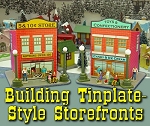 Building TinPlate-Syle Store Fronts -
Expanding our Tribute to Tinplate(tm) community is a set of down-town-style store fronts inspired by a series of tinplate candy containers that were made in the early -to-mid 1900s by West Brothers. The original containers were pretty small, but we've redrawn the graphics in larger scales and added a bit of additional detail so they'll fit into any tinplate or faux-tinplate setting. Building TinPlate-Syle Store Fronts -
Expanding our Tribute to Tinplate(tm) community is a set of down-town-style store fronts inspired by a series of tinplate candy containers that were made in the early -to-mid 1900s by West Brothers. The original containers were pretty small, but we've redrawn the graphics in larger scales and added a bit of additional detail so they'll fit into any tinplate or faux-tinplate setting.
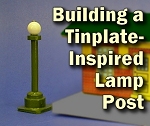 New
Feature - Building a Tinplate-Inspired Lamp Post The ideal accessory for the Lewis Park Station, or any station or city hall on your railroad or holiday village. No, they don't actually light, but they are cheap and easy to build and add a great deal of vintage interest to any setting. Free downloadable plans are available in several scales. New
Feature - Building a Tinplate-Inspired Lamp Post The ideal accessory for the Lewis Park Station, or any station or city hall on your railroad or holiday village. No, they don't actually light, but they are cheap and easy to build and add a great deal of vintage interest to any setting. Free downloadable plans are available in several scales.
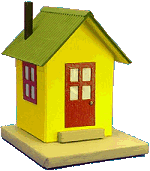 New
Feature - Building a Tinplate-Inspired Watchman's Shanty Back in the day before automated crossings, these were common sites alongside busy rail crossings. Howard's exclusive design pays tribute to a series of tinplate structures that go back a hundred years and include three different scales. His free plans and instructions will help you dress up any indoor railroad or holiday village. New
Feature - Building a Tinplate-Inspired Watchman's Shanty Back in the day before automated crossings, these were common sites alongside busy rail crossings. Howard's exclusive design pays tribute to a series of tinplate structures that go back a hundred years and include three different scales. His free plans and instructions will help you dress up any indoor railroad or holiday village.
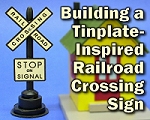 New
Feature - Building a Tinplate-Inspired Railroad Crossing Sign This is the ideal accessory for the Watchman's Shanty project. Based on a series of products that are now available only as expensive collector's items, this easy and almost-free project will add texture, interest, and period to any model railroad or holiday village. New
Feature - Building a Tinplate-Inspired Railroad Crossing Sign This is the ideal accessory for the Watchman's Shanty project. Based on a series of products that are now available only as expensive collector's items, this easy and almost-free project will add texture, interest, and period to any model railroad or holiday village.
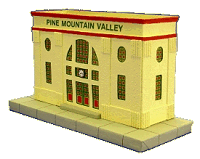 Building the Union Station - This original project by designer Howard Lamey is inspired by two traditions - the cardboard Christmas houses that were popular in US homes between 1928 and 1965 and the Lionel station that was popular for most of the 20th century. Building the Union Station - This original project by designer Howard Lamey is inspired by two traditions - the cardboard Christmas houses that were popular in US homes between 1928 and 1965 and the Lionel station that was popular for most of the 20th century.
- Easy Street Scene - This new
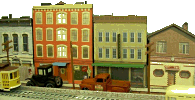 building project uses downloadable building graphics and a little cardboard or foam board to build up a convincing downtown scene that is only a few inches deep - perfect for shelf layouts, tight spots, and dioramas. We also provide links to high-resolution graphics that will work for any scale. building project uses downloadable building graphics and a little cardboard or foam board to build up a convincing downtown scene that is only a few inches deep - perfect for shelf layouts, tight spots, and dioramas. We also provide links to high-resolution graphics that will work for any scale.

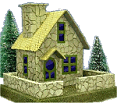 Build a Vintage-Style Cardboard Stone Cottage - This building project is made like the vintage cardboard houses folks used to set around their Christmas tree in the early 1900s (before glitterhouses became common), but its design was inspired by a building that shows up on the "Isle of Sodor." The building uses free downloadable graphic paper to put a realistic stone veneer on an old-world cottage and fence. It works with Christmas villages, or with a little customization, would dress up any indoor railroad. A "brick cottage" option is also shown.
Build a Vintage-Style Cardboard Stone Cottage - This building project is made like the vintage cardboard houses folks used to set around their Christmas tree in the early 1900s (before glitterhouses became common), but its design was inspired by a building that shows up on the "Isle of Sodor." The building uses free downloadable graphic paper to put a realistic stone veneer on an old-world cottage and fence. It works with Christmas villages, or with a little customization, would dress up any indoor railroad. A "brick cottage" option is also shown.
 Log Cabin Building Flat - This "building flat" uses downloadable graphics and foam board or cardboard to dress up a narrow corner of your railroad or village. The techniques in this project can be used for almost any kind of building you want to represent in a tiny space. December, 2007 Log Cabin Building Flat - This "building flat" uses downloadable graphics and foam board or cardboard to dress up a narrow corner of your railroad or village. The techniques in this project can be used for almost any kind of building you want to represent in a tiny space. December, 2007
- Build a Vintage-Style Barn and Silo - This
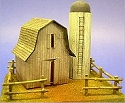 building project uses downloadable graphics to put realistic shingles and siding on an old barn and silo. Like the stone cottage above, it works with Christmas villages, or with a few changes, it would dress up an indoor railroad. building project uses downloadable graphics to put realistic shingles and siding on an old barn and silo. Like the stone cottage above, it works with Christmas villages, or with a few changes, it would dress up an indoor railroad.
Other Articles about cardboard houses include:
To Return to the Howard's How-To Page, click here.
|
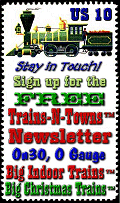

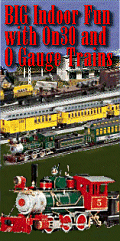

|







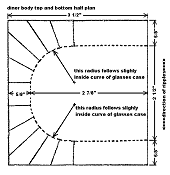
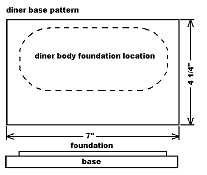
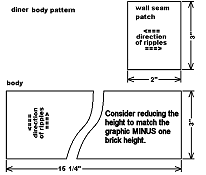
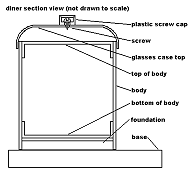
 Printing the Graphics - We've provided three versions to help you print the "lithograph" graphics at the size you need.
Printing the Graphics - We've provided three versions to help you print the "lithograph" graphics at the size you need.






 Building Tinplate-Inspired Goose-Neck Lamp Posts
Building Tinplate-Inspired Goose-Neck Lamp Posts

 Building TinPlate-Syle Store Fronts
Building TinPlate-Syle Store Fronts New
Feature - Building a Tinplate-Inspired Lamp Post
New
Feature - Building a Tinplate-Inspired Lamp Post New
Feature - Building a Tinplate-Inspired Watchman's Shanty
New
Feature - Building a Tinplate-Inspired Watchman's Shanty New
Feature - Building a Tinplate-Inspired Railroad Crossing Sign
New
Feature - Building a Tinplate-Inspired Railroad Crossing Sign Building the Union Station
Building the Union Station 















